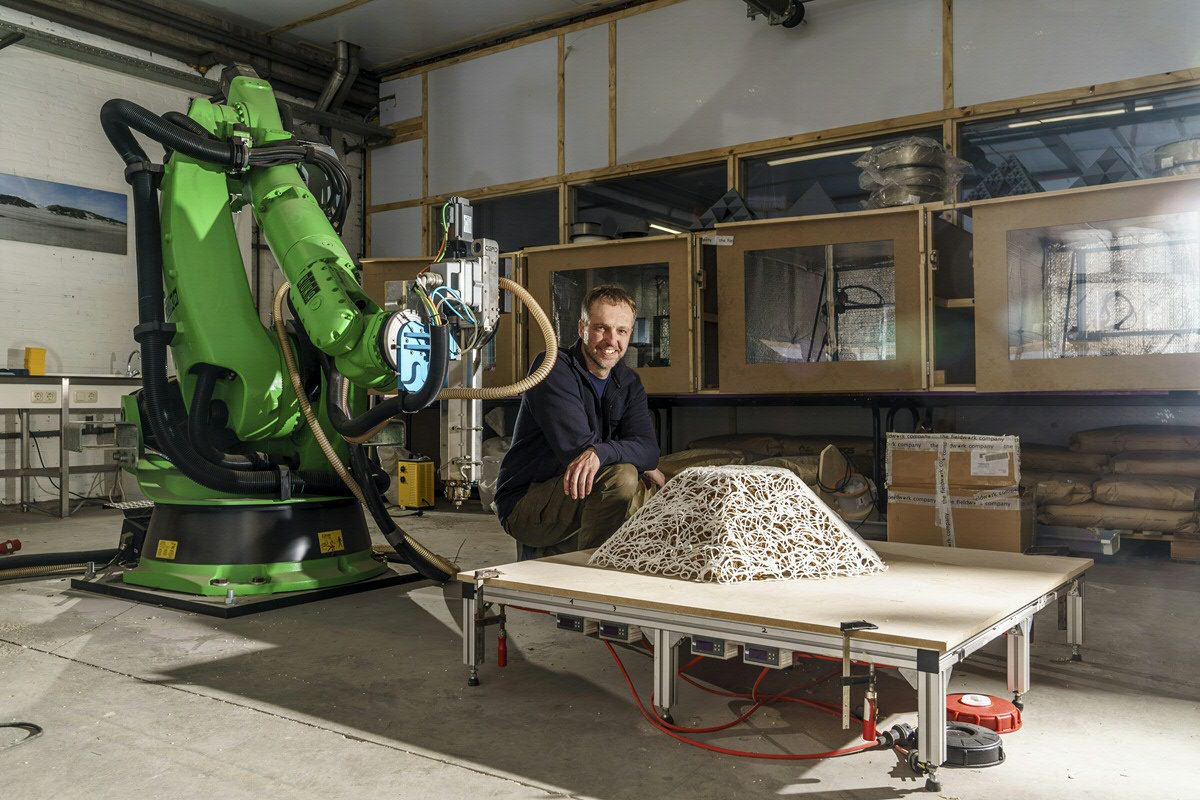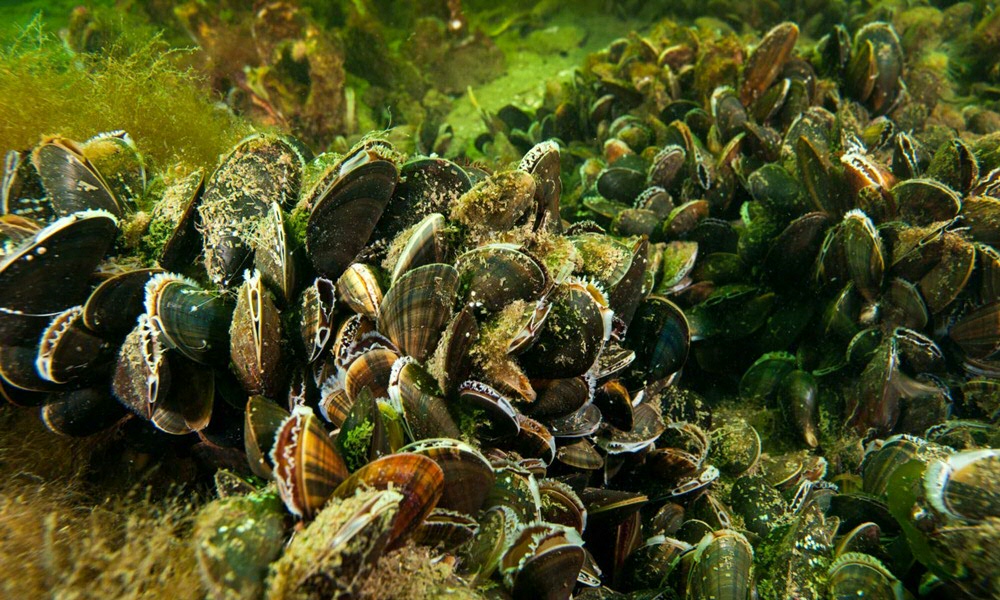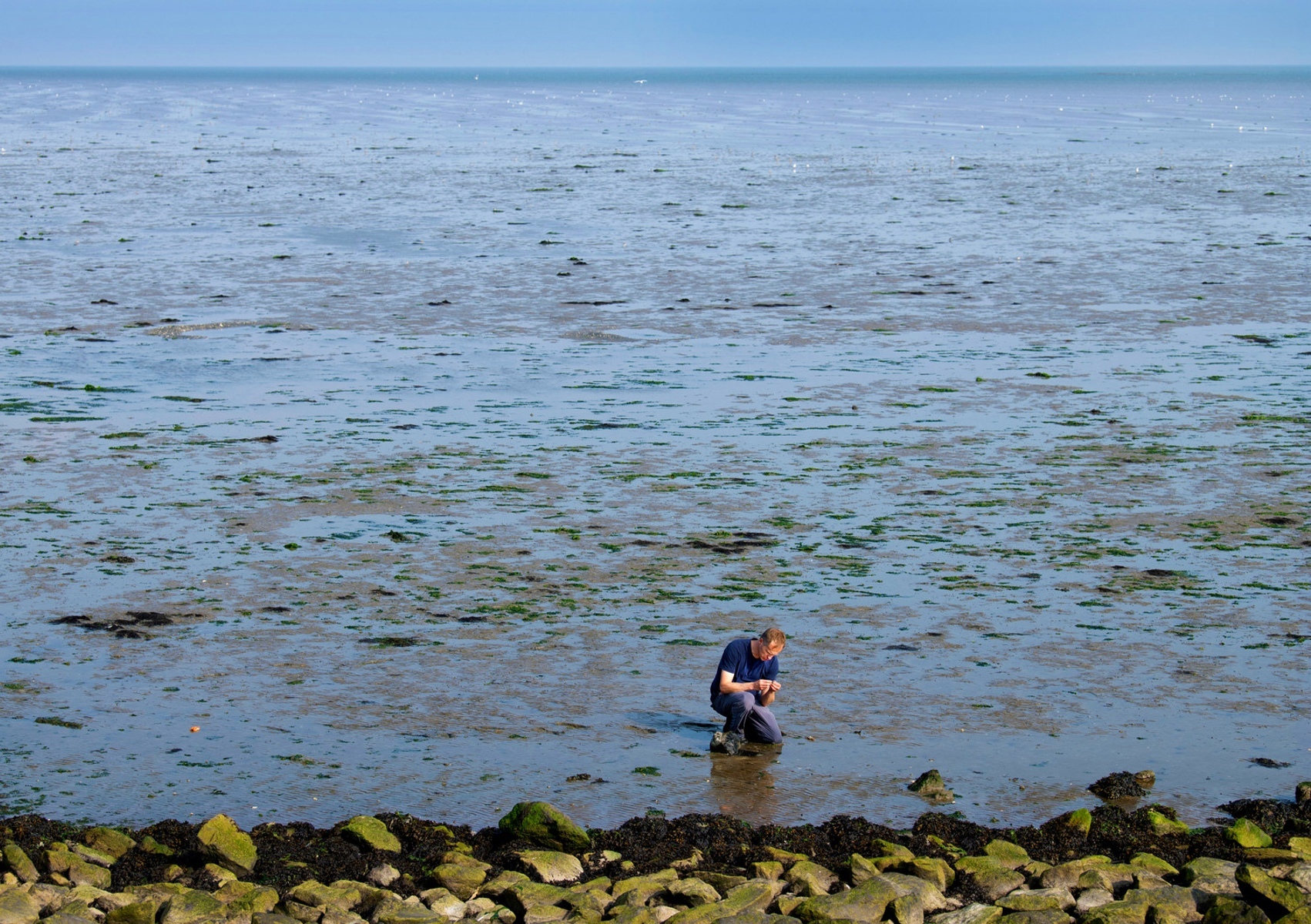Eén mossel kan geen rif maken
Hoogleraar kustecologie Tjisse van der Heide doet onderzoek naar herstel van mosselbanken en andere biobouwers, zoals men de levende organismen noemt die het Waddenlandschap vormgeven. Gewapend met een 3D-printer en industrieel-ontwerpmethoden werd hij zelf een biobouwer en zoekt hij uit wat er nodig is voor herstel van deze systemen.
Tekst: Nienke Beintema / Foto’s: Olaf Kraak, Reyer Boxem en Cor Kuijvenhoven
In een loods op een Gronings industrieterrein staat een enorme, kikkergroene robotarm: twee meter hoog, een meter in doorsnee en honderden kilo’s zwaar. Ooit laste hij onderdelen in elkaar voor een grote autofabrikant. Nu zit er een 3D-printkop op en print hij bio-afbreekbare manden ter grootte van een flinke barbecueschaal. Tjisse van der Heide laat er een hele stapel zien, in verschillende maten en ontwerpen. ‘Die liggen binnenkort op de bodem van de Waddenzee’, zegt de hoogleraar kustecologie aan de RUG en onderzoeker bij het Koninklijk Nederlands Instituut voor Onderzoek der Zee (NIOZ).

Bioplastic
Maar waarom…? Waarom plastic structuren - ook al is het dan bioplastic - neerleggen in onze fraaie Waddenzee? Van der Heide gaat er eens goed voor zitten en toont plaatjes op zijn laptop. In zandige kustecosystemen zoals de Waddenzee, zo legt hij uit, is een belangrijke rol weggelegd voor zogeheten biobouwers – in het Engels ook wel ecosystem engineers genoemd. Dat zijn levende organismen die het landschap mede vormgeven. Van der Heide: ‘Biobouwers zijn letterlijk en figuurlijk het fundament van het ecosysteem.’ Mossels vormen bijvoorbeeld mosselbanken waarop jonge mossels zich kunnen vestigen, en die ook een thuis vormen voor allerlei andere zeedieren. Helmgras houdt zandkorrels vast en bouwt zo hele duinlandschappen. Kwelderplanten vangen slib in en vormen uiteindelijk een kwelder. En zeegras vangt sediment uit het water, houdt dit vast en vormt een belangrijke leefomgeving voor andere mariene soorten.
Beschermd en schoner
‘Maar op veel plekken in de Waddenzee zijn deze natuurlijke systemen verdwenen’, vertelt Van der Heide. ‘De mossel- en oesterbanken zijn in het verleden overbevist. Zeegras had te lijden van een ziekte, van de aanleg van de Afsluitdijk en van vermesting door landbouw en fosfaat uit wasmiddelen.’ Nu de Waddenzee beter beschermd en schoner is, zouden die soorten weer kunnen terugkeren; en meer kwelders, riffen en duinen zijn altijd welkom in de strijd tegen een stijgende zeespiegel. Maar dit gaat lang niet overal vanzelf. ‘Eén mossel kan geen rif maken’, vat Van der Heide de uitdaging samen. ‘Een mossel kan zich in zijn eentje niet hechten aan de zeebodem. Hij spoelt weg met de eerste golf. Hetzelfde geldt voor het eerste kwelderplantje, het eerste plukje helmgras, de eerste stengel van zeegras. Al die soorten groeien pas goed als er al een stevige basis is.’

Ideale broedplek
Ziedaar het nut van de geprinte manden van afbreekbaar bioplastic. Twee van die manden in elkaar, met een lapje kokosmat ertussen, en dan omgekeerd – als een heuveltje – op de zeebodem verankerd, bootsen een volwassen mosselbank na en blijken zo een ideale broedplek te zijn voor piepjonge mossels. Die hechten zich met hun draden aan de kokosvezels, die blijkbaar genoeg lijken op de draden van soortgenoten. Als ze groter worden, groeien ze verder op de hardere structuren van het plastic. ‘Het is de bedoeling dat het bioplastic in de loop van een paar jaar vanzelf wordt afgebroken in het zeewater en dat de mossels het dan verder zelf kunnen’, vertelt de ecoloog. ‘Daar doen we onderzoek naar. Het afbreken moet niet te snel gaan, maar ook weer niet te langzaam. En je moet voorkomen dat je losse brokstokken krijgt die gaan rondzwerven.’
Industrieel ontwerp
Die bio-afbraak is slechts een van de factoren die Van der Heide en zijn collega’s onderzoeken. Dat doen ze hier, in deze loods van The Fieldwork Company (TFC) op het Groningse industrieterrein, maar ook achter de computer op de universiteit en bij het NIOZ, én op proeflocaties in de Waddenzee. Om te laten zien wat hij nog meer onderzoekt, tovert Van der Heide op zijn scherm een enorme matrix tevoorschijn. ‘We ontwikkelen nu een methode die we ontlenen aan het industrieel ontwerpen’, legt hij uit. ‘Horizontaal zet je de verschillende eisen waaraan je ontwerp moet voldoen. Het moet bijvoorbeeld zorgen voor stevigheid, goede aanhechting, golfdemping, bescherming tegen predatoren, en dus precies de juiste afbreekbaarheid. En het liefst wil je ook nog eens dat het de lokstoffen afgeeft die een natuurlijk rif uitscheidt en zwemmende mossellarven op afkomen.’
Trucjes en foefjes
Verticaal zet je dan verschillende oplossingen voor al die vraagstukken. Alternatieve opties voor vormen, materialen, trucjes en foefjes – veelal uit andere sectoren, zoals de industrie of de visserij. ‘En dan ga je dingen combineren. Op een heel gestructureerde manier verschillende prototypes maken. En die dan uitproberen. Dat is de leuke fase’, vertelt Van der Heide energiek. Dat uitproberen doet hij deels samen met adviesbureau Waardenburg Ecology, maar ook met de mensen van TFC met wie hij de 3D-printer deelt. TFC helpt instellingen met de technische kant van hun veldwerk. Het bedrijf ontwerpt en maakt bijvoorbeeld drones met ingebouwde camera’s voor monitoring. ‘Ideaal, dat ik samen met hen aan dit soort vraagstukken kan werken’, vindt Van der Heide. ‘Een expert van TFC helpt bijvoorbeeld met de details van dat 3D-printen. Hij vindt dat leuk om te doen. En ik ook.’ Van der Heide lacht. ‘Dat printen is inmiddels een beetje een uit de hand gelopen hobby.’

Prototypes werken goed
De eerste prototypes hebben hun diensten al bewezen op verschillende proeflocaties. Dit principe, dus het tijdelijk nabootsen van een biobouwer om die te helpen zich te vestigen, blijkt heel goed te werken, aldus de onderzoeker: ‘Voor alle vier de systemen: helmgras, kweldervegetatie, zeegras en mosselen.’ Voor de volgende fasen heeft Van der Heide een aanvraag voor een Vici-subsidie lopen bij NWO. Hij is al door naar een volgende selectieronde, maar de concurrentie is groot. ‘Als dit niet doorgaat, dan vind ik het geld wel op een andere manier. We gaan hier zeker mee door.’
Dat opbouwende is mooi
Wordt Van der Heide er weleens treurig van, dat zijn werk is gericht op het herstellen van wat mensen ooit kapot hebben gemaakt? ‘In zekere zin natuurlijk wel’, zegt hij, ‘maar dat opbouwende, dat is dan juist weer heel mooi. Zeker als het werkt. En daarbij doen we ook heel veel fundamentele kennis op: hoe helpen die systemen zichzelf? Wat is daarvoor nodig? En hoe kunnen we die kennis vervolgens toepassen voor grootschalig herstel, hier, maar ook bijvoorbeeld in mangrovebossen of op oesterbanken elders in de wereld? Het is heel mooi om zo te kunnen bijdragen aan concrete oplossingen.’
Tjisse van der Heide studeerde aquatic ecology in Wageningen en promoveerde in 2012 als marien ecoloog in Nijmegen. In 2018 werd hij hoogleraar kustecologie aan het GELIFES instituut van de RUG en ontving hij een Vidi-subsidie van NWO. Ook is hij onderzoeksleider bij het NIOZ op Texel. Zijn onderzoek spitst zich toe op kustecosystemen en de rol van biobouwers. Hij kwam veel in het nieuws, onder meer vanwege zijn bezwaren tegen een stroomkabel door een kwetsbaar tracé in de Waddenzee.
Dit artikel is verschenen in de online herfsteditie 2023 van ons alumnimagazine Broerstraat 5
Meer informatie
Meer nieuws
-
19 december 2025
Mariano Méndez ontvangt Argentijnse RAÍCES-prijs
-
18 december 2025
Waarom innoveren, en voor wie?
-
17 december 2025
Ben Feringa wint Feynmanprijs
